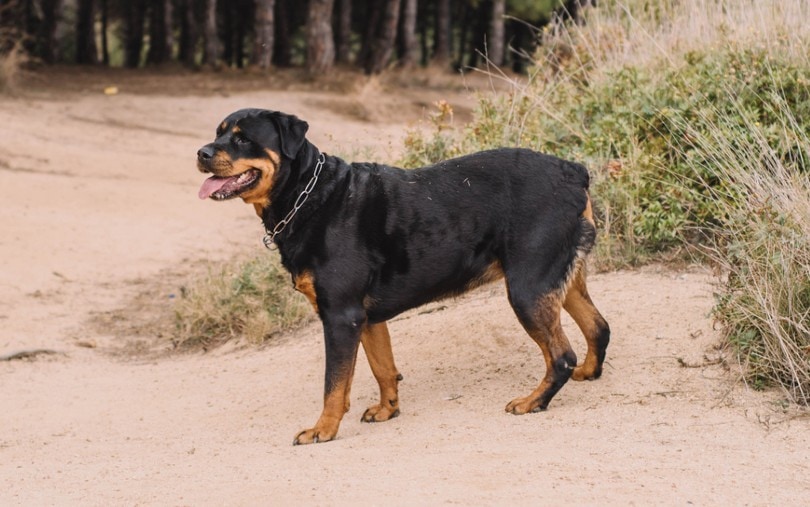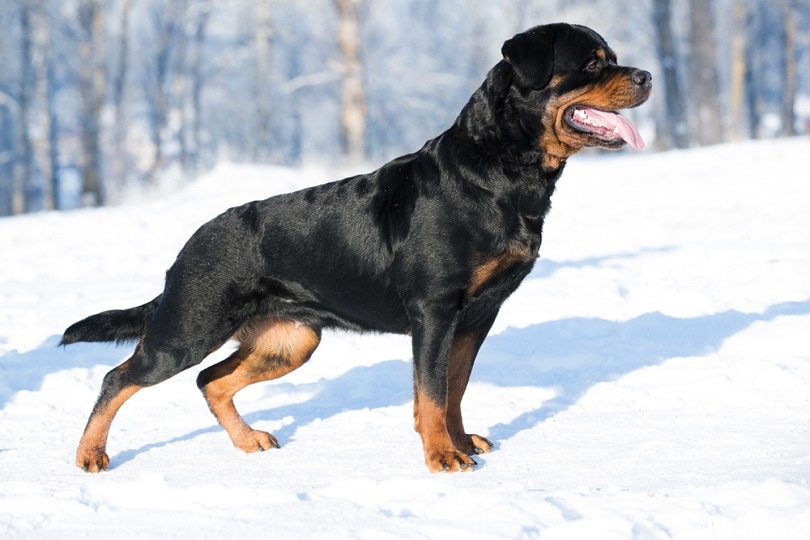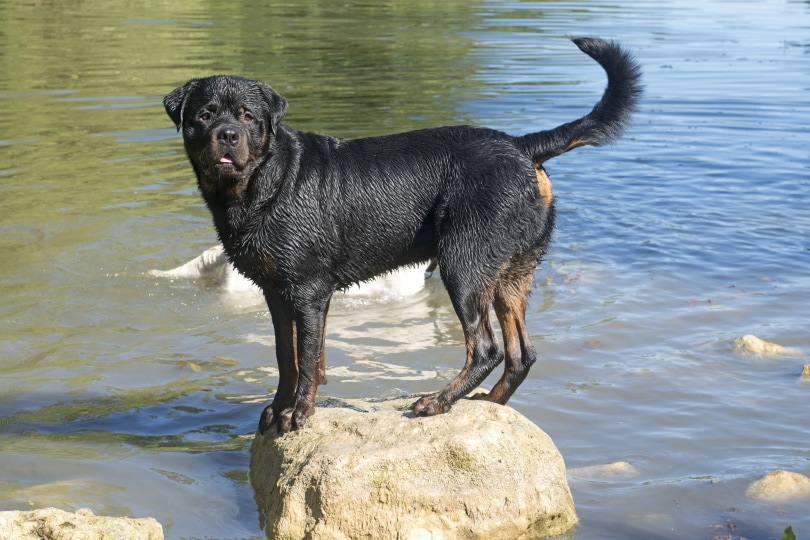If you are getting a Rottweiler puppy, your breeder may have asked if you want its tail docked. Even though many Rottweiler owners decide to dock the tail, it is absolutely not necessary. In fact, docking a Rottweiler’s tail is an unnecessary medical procedure that many charities and organizations argue against.
To decide whether you should dock your Rottweiler’s tail or not, read on. This article fully explains the legality, ethics, and behavior behind docking a Rottweiler’s tail.
Dogster does not support tail docking. Instead, allow your Rottie to communicate with its tail by leaving its tail to grow naturally.
Are Rottweilers Born With Tails?
Even though many Rottweilers today are seen with virtually no tail, they are born with regular tails like most other dogs. The only reason why Rottweilers today are often associated with the no tail look is because of docking. Docking is the practice where an individual, such as a breeder or veterinarian, removes the tail when the dog is a puppy.

Why Do Rottweilers Have Docked Tails?
There are two main reasons why Rottweilers have docked tails: functionality and showing purposes. Historically, owners have docked the Rottweiler’s tail to protect the dog while it is pulling carts and herding animals. Given that very few Rottweilers work as working dogs today, most docked tails are due to showing purposes or aesthetics.
Functionality
Even though there are not many uses for working dogs today, many of the purebred dogs available were bred originally for working purposes. The Rottweiler, for example, was bred for pulling carts, herding cattle, and other various tasks.
Because of the nature of these jobs, the Rottweiler’s tail often got in the way of the dog’s work. When pulling carts, the tail often got stuck and caused the dog great pain. Likewise, cattle would sometimes go after the dog’s tail when the dog worked as a herder, once again causing pain.
To help keep the dogs safe, Rottweiler owners got into the habit of automatically docking the dog’s tail as it was a puppy. Docking the tail meant that it wouldn’t get in the way and cause undue harm when the dog was an adult.

Showing
Because Rottweilers are not used for working purposes anymore, most people only dock their tails due to showing aesthetics. According to AKC breed standards, Rottweilers must have docked tails. What this means is that a Rottweiler without a docked tail cannot be shown.
Because the AKC views a docked tail as a breed standard, many breeders automatically dock their dogs’ tails as well. This can make it hard to find puppies without already docked tails, even if you have no intention of showing the dog.
Rottweiler With Tail vs Without
Because Rottweilers and other breeds are so frequently docked, you might not think that docking has any impact on the dog. Although docking a Rottweiler doesn’t lead to serious medical issues, it does change how the dog communicates and behaves.
Purpose of a Tail
The whole purpose of a dog tail is to communicate information and to help the dog keep its balance. The same is true of the Rottweiler’s tail.
As for communication, dogs can express how they feel by changing their tail. As you likely know, dogs wag their tail when happy or excited. Rottweiler’s hang their tails naturally when relaxed or hold it upright and slightly curled when excited.
Likewise, the tail helps the dog to keep its balance. When simply walking and running, the tail maintains symmetry in the dog’s body, helping it to remain upright, even when on the hunt.

How the Dog Behaves Without a Tail
If you remove the tail from the Rottweiler, the dog loses its natural way to communicate and keep balance. For the most part, the dog will try to communicate with its tail, which can be seen when a happy Rottweiler wags its little nub.
Even though the dog thinks it is still communicating with its tail, its small size can make it more difficult for other dogs to recognize what the Rottweiler is trying to communicate, resulting in more dog fights and issues.
Similarly, Rottweilers with docked tails have more difficulty when it comes to balance and agility. Since these dogs are so athletic as is, the change in balance might not seem like much to us, but it certainly impacts the dog’s quality of life.
Does Docking a Rottweiler’s Tail Hurt?
Most people dock the tail of a Rottweiler when it is only a couple of days old. At this point, the nervous system won’t be as developed as it is in an adult dog. So, the procedure doesn’t hurt a puppy as badly as it hurts an adult dog, or at least that’s the theory.
Still, docking a Rottweiler’s tail hurts the dog. Especially when the dog is a puppy, very few breeders or vets take the time to offer any form of anesthetic or sedation. This means that the puppy feels the entire procedure, including cutting through its skin, muscles, nerves, and bone.
Simply by putting yourself in the dog’s shoes, you could easily imagine just how painful this experience is for the Rottweiler, even as a puppy.
Because docking a Rottweiler’s tail is completely unnecessary yet painful, most veterinarians today refuse to do it. You can occasionally find a veterinarian that offers the procedure, but it is typically very expensive. Since many veterinarians refused to dock a Rottweiler’s tail, many amateurs attempt to do it instead, which results in an even more painful experience for the dog.

Is It Legal to Dock a Rottweiler’s Tail?
The United States is one of the only countries that does not regulate dog tail docking. Most other European and Western countries have made it illegal, resulting in fines or jail time if you dock a dogs’ tail. In fact, almost 40 countries have restricted or outright banned the practice.
Should I Dock My Rottweiler’s Tail?
After considering the legality and lasting impact of docking your Rottweiler’s tail, it’s time to make the decision for yourself: should you dock your Rottweiler’s tail? For the sake of nearly every dog, we do not recommend docking your Rottweiler’s tail. The only exception is if you explicitly intend to show the dog at AKC events.
No
We do not recommend docking your Rottweiler’s tail. Even though docking the tail did serve a functional purpose at one point in history, it doesn’t serve the same purpose today. The practice is useless in terms of functionality. At the same time, the dog experiences pain, and lifelong implications of the tail docking, such as inadequate communication and balance.
Because tail docking serves no function, hurts the dog, limits communication, and infringes on its balance, you should not dock a Rottweiler’s tail, or any other dog’s tail either. Not only is it cruel to the dog, but it wastes unnecessary money.

Yes
The only time you should dock your Rottweiler’s tail is if the dog gets some sort of injury and docking is recommended by the veterinarian. In this case, the dog will likely be put under anesthesia, and it won’t experience the same amount of pain as traditional tail docking.
You must also dock your dog’s tail if you intend to show it at AKC events. You will not be able to show your Rottweiler if its tail is not docked. Unless you are sold on AKC events, we recommend checking out different dog showing organizations that do not require you to dock the tail. That way, you can still show your dog without chopping off one of its body parts.
If you must get your Rottweiler’s tail docked, only get it done by professionals who know what they’re doing. Even though all tail docking is painful, a professional will be able to get the job done quickly and efficiently to reduce unnecessary pain. Do not allow amateurs or hobbyists to dock your Rottweiler’s tail because it may lead to more pain and lifelong implications.
Take Away
We do not recommend docking your Rottweiler’s tail. Not only will the procedure hurt your dog, but it will prevent the dog from communicating properly or having proper balance. All the while, there is no purpose for docking the dog’s tail anymore, making the pain completely unnecessary.
Unfortunately, you will have to dock your Rottweiler’s tail if you want to show it at AKC events. Many organizations and people are currently speaking out against tail talking. Hopefully, AKC will change this standard in the future so that Rottweilers with natural tails can be shown as well.
Featured Image Credit by: BIGANDT.COM, Shutterstock











